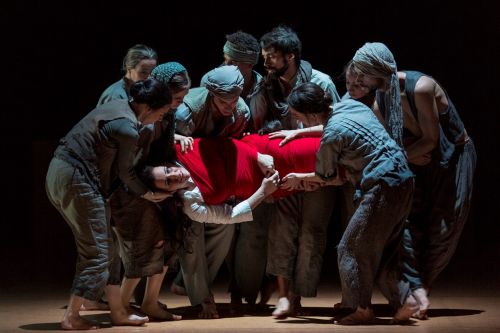 Sweden John Adams: A Flowering Tree Soloists, Gothenburg Opera Orchestra and Chorus, Joanna Carneiro (conductor), Gothenburg Opera main stage, 7.2.2015 (NS)
Sweden John Adams: A Flowering Tree Soloists, Gothenburg Opera Orchestra and Chorus, Joanna Carneiro (conductor), Gothenburg Opera main stage, 7.2.2015 (NS)

Cast:
Singers:
Kumudha: Julia Sporsén
The Prince: Eric Fennell
The Narrator: Omar Ebrahim
Dancers:
The Prince’s sister: Vivian Koohnavard
Kumudha’s mother: Monica Milocco
The King: Vadim Nuñes Belousova
Kumudha’s sister: Sara Suneson
Other dancers: Sara Andrén, Lena-Maria Fistarol, Jozsef Forro, Björn Nilsson, Victoria Roberts, Yari Stilo.
Production:
Chicago Opera Theater and Teatro Communale di Bolzano
Direction: Nicola Raab
Choreography: Renato Zanella
Choreographic supervision: Benito Marcellino
Set and costume design: George Souglides
Lighting design: Aaron Black
Sound design: Andreas Renhorn
The Scandinavian premiere of John Adams’ A Flowering Tree at the Gothenburg Opera was a rarity in more ways than one – not only in that the work is rarely staged, but also in the rare synthesis of music, dance and direction to produce a real Gesamtkunstwerk. This visually enchanting production should be seen not only by opera lovers but also by ballet fans.
Nicola Raab’s visionary direction focussed on the music and the characters on stage, making excellent use of a minimalist set, beautiful costumes (both the responsibility of George Souglides) and Aaron Black’s atmospheric lighting. The stage was full of warm and rich colours, and the skilful positioning of chorus and dancers together with the imaginative use of simple props (an elephant was created in an instant by the chorus holding up a set of boards) made for great visual impact. This production has ten dancers rather than the three of the world premiere in Vienna, and Benito Marcellino’s choreography made good use of all of the dancers as well as the chorus.
John Adams’ music is well adapted to telling the story of transfiguration, love and jealousy in this ancient Indian folk tale. The dominant mood is lyrical and poetic rather than dramatic, though the major scenes for chorus and dancers are often rhythmic and exciting, influenced both by Latin American music and (in the dance of the wandering beggars) the Balinese Kecak dance. Mr Adams’ music wears its complexity lightly and is attractive to listen to, especially when combined with the visual beauty of this production.

Mats Bäcker
The Narrator begins the opera with the words “Children, I want to tell you a story” and has the longest vocal role. Omar Ebrahim was a figure of great dignity and gave us a lyrical baritone and clear enunciation of the text. His singing was particularly gripping as his voice echoed with the horror of Kumudha’s mutilation by the carelessness of her husband the Prince’s jealous sister and her spoilt friends.
Unlike the Narrator, both the Prince and Kumudha undergo transformations in the opera. Kumudha is magically transformed into a flowering tree, but each transformation is different: the first time is one of great serenity; the second is charged with her nervousness and her desire to break down the barrier between herself and her new husband; the third, when she is bullied into transforming for her sister-in-law, is a mixture of dignity (“respect the tree”) and her loneliness in the alien environment of a royal court. Julia Sporsén acts completely convincingly, both in the subtle differences of her transformations and in her terror when she finds herself stuck in a mutilated form, without limbs. Her soaring lyrical soprano expresses all of this beautifully.
The Prince’s (Eric Fennell) transformation is one of character: from a confident, privileged young man (exemplified in his love song on secretly seeing one of Kumudha’s transformations, brilliantly combined with a chorus) to a guilt-ridden penitent. The Prince’s sense of loss for Kumudha resulted in one of the finest musical moments in the opera, where he sings of his loss and his guilt and Kumudha simultaneously sings of her desolation from losing her husband (“we laughed nightly”) and losing her limbs and thus part of her humanity. This is musically a duet but the two characters are not yet reunited in the story. Their reunion and Kumudha’s final healing transformation is both dramatically and musically moving.
The chorus is very prominent in this opera, both when they combine with soloists and when they sing as part of dance music. The chorus has an extremely challenging role with onstage action, choreography and offstage singing where they essentially form a small part of Adams’ intricate orchestral structure. After a long and gruelling rehearsal period the result on the first night was a triumph – they not only performed faultlessly, they also provided real dramatic impetus.
The dancers also made a memorable contribution, often closely linked to the chorus. The solo dancing of Kumudha’s mother (Monica Milocco) and the King (Vadim Nuñes Belousova) was particularly fine but all the dancers were superb. The Gothenburg Opera Orchestra played the intricate score without ever becoming mechanical, instead they were wonderfully atmospheric. Joanna Carneiro (who assisted John Adams with the world premiere and has since conducted productions of A Flowering Tree) richly deserved her touche fanfare from the orchestra, and all the performers richly deserved their curtain calls.
Niklas Smith
This production was originally premiered by the Chicago Opera Theater and reviewed by Seen and Heard International in 2008. A synopsis is available on John Adams’ website .